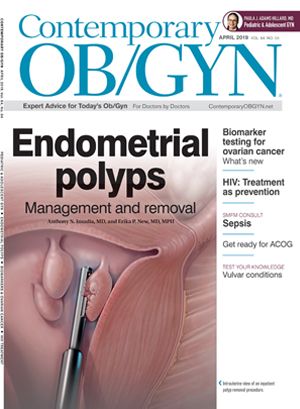What is pediatric and adolescent gynecology?
Talking with patients about their daughters is one way to build a practice focused on caring for girls, adolescents, and young adults.
©glisic_albina - stock.adobe.com

I know you’ve been there. Someone, somewhere, wanting to make conversation, asks you what type of work you do. Typically, I’ll answer that I’m a physician, and we all know that reply can trigger a long story from the questioner about their own latest encounter with the medical profession. Sometimes, if they are curious and ask for more information, “what type of doctor?”, I’ll respond that I’m a gynecologist. Before volunteering even this limited information, I’ll try to gauge their interest. If my questioner is a man, the conversation may quickly to turn another subject. This is certainly not always the case, and a man may choose to pursue a discussion, just as the subject may change when I am speaking with a woman. But more often than not, when speaking with a woman, the topic of gynecology or obstetrics leads to further discussion.
The conversation may then evolve to a discussion of my gynecology practice that no longer includes adult women, but which focuses on pediatric and adolescent gynecology (PAG). Here’s where I often see a puzzled look, and some variation on the question, “What on earth is pediatric and adolescent gynecology?”1 Many people are surprised that PAG is a “thing.” I may describe some of what I do as “preventive obstetrics,” which typically brings a smile or a chuckle, albeit often with a bit of lag time.
Preventing unintended pregnancies in adolescents is indeed a major focus of my practice, but my practice is much broader than just contraception. I see girls, adolescents, and young adult women in my practice at the Lucile Packard Stanford Children’s Hospital in Palo Alto, California. My patients come from all around the San Francisco bay area, as well as from much further afield in California and other parts of the western United States. I care for these individuals with problems ranging from abnormal menstrual bleeding, abnormal puberty (too early, or too late), vulvar and vaginal symptoms, pelvic/ovarian masses, pelvic pain, differences of sex development, concerns about sexually transmitted infections, congenital utero-vaginal variants, and much more.
I regularly provide preventive guidance to teens (and their parents), address anxieties about fertility and future reproductive health, encourage preventive services including human papillomavirus vaccinations, and talk about the benefits and risks of hormone therapies including oral contraceptives and hormonal intrauterine devices not only for contraception, but also for managing menstrual pain, irregular bleeding, or heavy menstrual bleeding. I talk about condoms, safe sex, responsible sex, abstinence, self-esteem, bullying, and uncover never-before-disclosed sexual abuse. I answer questions about normal anatomy-breasts of different sizes, or labia that may not look like the idealized images of porn stars on the Internet. Once you earn their trust with honest answers and sincerity, teens will confide a lot-including their hopes, dreams, fears, and foibles. And if I’m lucky and have the privilege of seeing an individual weather her teen years into young adulthood, I’m often witness to the amazing transformation of adolescent development.
If you practice general obstetrics and gynecology, and if you enjoy taking care of teens, you likely do some or all of these things in your ob/gyn practice. I just do them every day. If you don’t like taking care of adolescents (and if you’re the parent of a teen, you’ll understand that they can be prickly at times, and that eye-rolling is par for the course), then you probably shouldn’t do much of it. Most teens are pretty discerning, and it’s hard to fake sincerity. But if you remember how hard it was to BE a teen, and how much you would have appreciated a caring physician who addressed your concerns about growing up (including menstrual concerns, if you identify as female), you may want to learn more about PAG and include more adolescents in your practice. I have no doubt that if you want to do this, and you start to ask your adult patients about their adolescent daughters, you will begin to build a practice that includes adolescents. The American College of Obstetricians and Gynecologists recommends that the initial visit for screening and provision of preventive health care services should take place between ages 13 and 15, and the Committee Opinion on The Initial Reproductive Health Visit provides guidance and resources for that visit.2 Most moms of teens are unaware of this recommendation-YOU may even be unaware of this recommendation.
The CREOG educational objectives include topics on pediatric and adolescent gynecology,3 and more and more residency training programs have faculty with expertise and experience in dealing with girls and adolescent young women, so that current residents are better prepared than ever before to care for this underserved population. For residency programs without PAG-trained faculty, or for individuals in practice who want to learn more PAG, two publications (dubbed the Short and the Long curriculum) provide a standard curriculum with resources and guidance for self-learning.4,5 The American Board of Obstetrics and Gynecology (ABOG) includes articles on PAG among the lifelong learning papers for Maintenance of Certification (MOC).6 For the first time, in 2018, ABOG offered an examination and focused practice designation in PAG. The North American Society for Pediatric and Adolescent Gynecology (NASPAG) website offers resources for clinicians, patient handouts, and the annual clinical and research meeting each May is a wonderful Continuing Medical Education (CME) opportunity for learning more about caring for young girls’ and teens’ gynecologic needs.7 The next NASPAG meeting will be held in New Orleans on April 11-13, 2019.
I’ve been on the editorial board of Contemporary OB/GYN since 1992, and I am passionate about the clinically relevant articles that you and I read on a regular basis. Contemporary OB/GYN has published a number of excellent reviews of PAG topics, including eating disorders,8 heavy menstrual bleeding in adolescents,9 and pelvic pain in the adolescent,10 These reviews are great places to start reading if you want to become more familiar with care of adolescents and young girls. I thank Charly Lockwood for his leadership as Editor-in-Chief of Contemporary OB/GYN, as well as my fellow editorial board members for their dedication to this publication. I’m grateful that they have allowed me this forum to be an evangelist for Pediatric and Adolescent Gynecology. My PAG practice is never boring. I would encourage you to add care for more adolescents and young girls to your practice of general obstetrics and gynecology. It is gratifying, and much appreciated by the girls and their mothers.
Disclosures:
The author reports no potential conflicts of interest with regard to this editorial.
References:
- Adams Hillard PJ. What is pediatric and adolescent gynecology? J Pediatr Adolesc Gynecol. 2018;31(2):77-78.
- ACOG Committee Opinion no. 598: Committee on Adolescent Health Care: The initial reproductive health visit. Obstet Gynecol. 2014;123(5):1143-1147.
- American College of Obstetricians and Gynecologists. CREOG 11th edition of educational objectives. Available at https://www.acog.org/About-ACOG/ACOG-Departments/CREOG/CREOG-Search/CREOG-11th-Edition-of-Educational-Objectives. Accessed July 20, 2018.
- Fleming N, Amies Oelschlager AM, Browner-Elhanan KJ, et al. Resident education curriculum in pediatric and adolescent gynecology: the short curriculum. J Pediatr Adolesc Gynecol. 2014;27(2):117-120.
- Loveless M, Amies Oelschlager AM, Browner-Elhanan KJ, et al. Long curriculum in resident education. J Pediatr Adolesc Gynecol. 2015;28(3):196-206.
- American Board of Obstetrics and Gynecology. Why is MOC important? Available at https://www.abog.org/new/information.aspx?cat=moc&id=1. Accessed July 20, 2018.
- North American Society for Pediatric and Adolescent Gynecology. https://www.naspag.org. Accessed July 20, 2018.
- Snyder B. Eating disorders in adolescents and young adult women: Implications for reproductive health. Contemp OB/GYN 2014; http://www.contemporaryobgyn.net/obstetrics-gynecology-womens-health/eating-disorders-adolescents-and-young-adult-women-implications-reproductive-health.
- Heavy menstrual bleeding in adolescents. Contemp OB/GYN. 2013; http://www.contemporaryobgyn.net/modern-medicine-news/heavy-menstrual-bleeding-adolescents.
- Pelvic pain in the adolescent. Contemp OB/GYN. 2013. http://www.contemporaryobgyn.net/endometriosis/pelvic-pain-adolescent

Study links COVID-19 infection to higher low birthweight and preterm birth rates
March 24th 2025A new study found that pregnant women infected with COVID-19, especially in the third trimester or with severe symptoms, faced higher risks of preterm birth, low birthweight, and neonatal intensive care unit admission.
Read More
